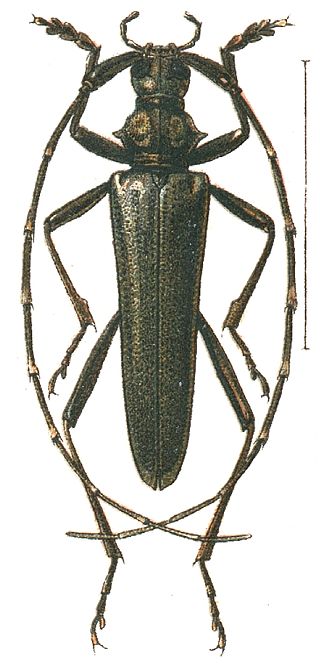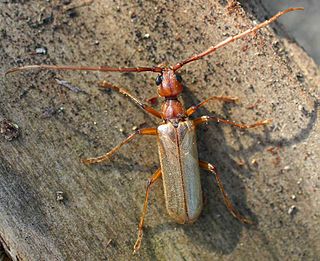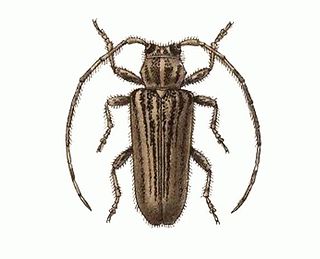Related Research Articles

The longhorn beetles (Cerambycidae), also known as long-horned or longicorns, are a large family of beetles, with over 35,000 species described.

The Chrysomeloidea are an enormous superfamily of beetles, with tens of thousands of species. The largest families are Cerambycidae, long-horned beetles, with more than 35,000 species, and Chrysomelidae, leaf beetles, with more than 13,000 species.

The Disteniidae are a small family of beetles in the superfamily Chrysomeloidea, traditionally treated as a group within the Cerambycidae.

The Vesperidae are a small family of beetles, normally classified within the family Cerambycidae, of heterogeneous aspect but all characterised by larval stages related to roots of herbaceous plants or trees

Clytus arietis, the wasp beetle, is a wasp-mimicking longhorn beetle species in the genus Clytus.

Lepturinae, the lepturine beetles, is a subfamily of the longhorn beetle family (Cerambycidae), containing about 150 genera worldwide. This lineage is most diverse in the Northern Hemisphere. Until recently the subfamily Necydalinae was included within the lepturines, but this has been recently recognized as a separate subfamily. Nine tribes are usually recognized today, with a tenth, Caraphiini, created in 2016. A few genera are of uncertain placement within the subfamily.
Mocquard's worm snake is a species of snake in the family Typhlopidae. The species is native to Africa.
Microodes is a genus in the ground beetle family Carabidae. There are about six described species in Microodes.
Dyscaris is a genus in the ground beetle family Carabidae. There are at least four described species in Dyscaris, found in Madagascar.

Trachyderini is a tribe of long-horned beetles in the family Cerambycidae. There are at least 140 genera and 650 described species in Trachyderini.
Abacetus decorsei is a species of ground beetle in the subfamily Pterostichinae. It was described by Tschitscherine in 1901.

Crossotini is a tribe of longhorn beetles of the subfamily Lamiinae. It was described by Thomson in 1864.

Megalofrea is a genus of longhorn beetles of the subfamily Lamiinae.

Megalofrea bioculata is a species of beetle in the family Cerambycidae. It was described by Fairmaire in 1889. It is known from Madagascar.
Megalofrea cinerascens is a species of beetle in the family Cerambycidae. It was described by Fairmaire in 1901. It is known from Madagascar.
Megalofrea humeralis is a species of beetle in the family Cerambycidae. It was described by Vollehoven in 1869. It is known from Madagascar.
Megalofrea sparsuticollis is a species of beetle in the family Cerambycidae. It was described by Fairmaire in 1897. It is known from Madagascar.
Estola brunnescens is a species of beetle in the family Cerambycidae. It was described by Stephan von Breuning in 1940. It is known from Colombia and Venezuela.
Estola freyi is a species of beetle in the family Cerambycidae. It was described by Stephan von Breuning in 1955. It is known from Trinidad.

Estola vittulata is a species of beetle in the family Cerambycidae. It was described by Henry Walter Bates in 1874. It is known from Panama, Mexico and Venezuela.
References
- ↑ BioLib.cz - Megalofrea decorsei. Retrieved on 8 September 2014.
- ↑ "Megalofrea decorsii". lamiinae.org. Retrieved 2025-01-31.